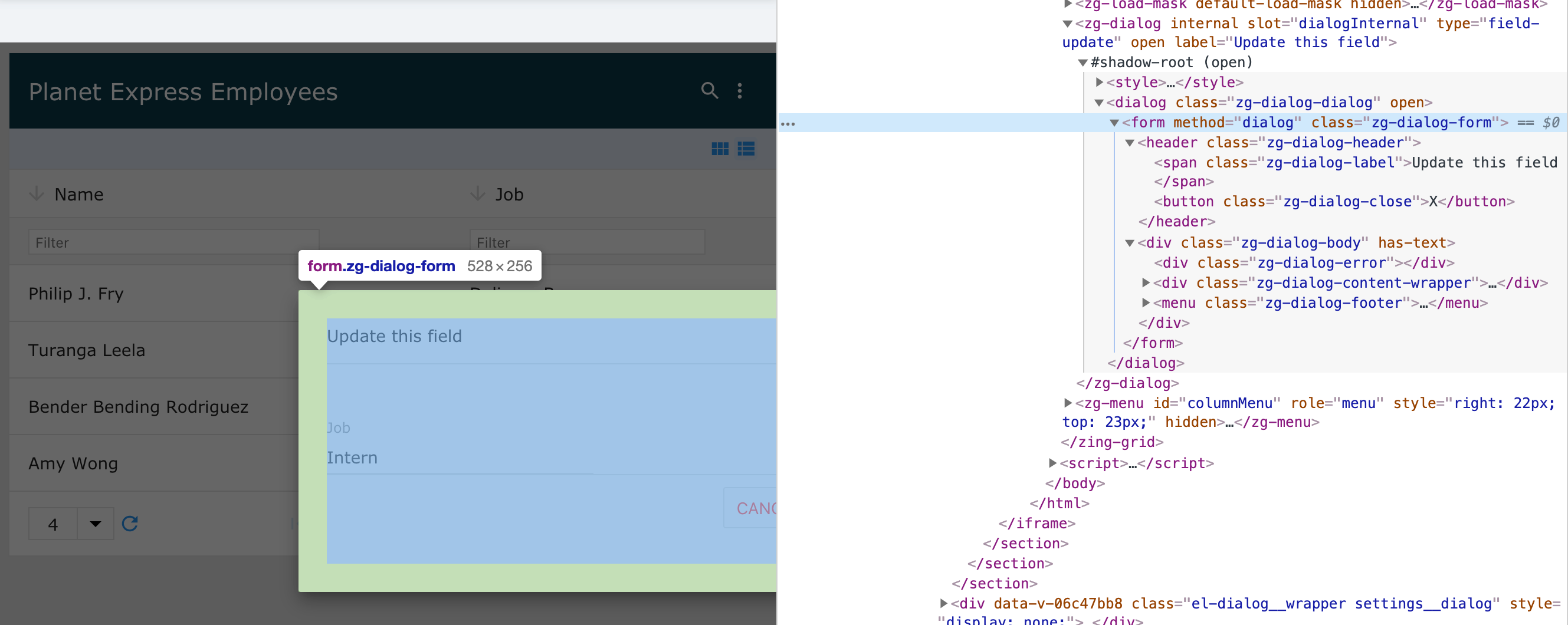<zg-dialog>
Interactive Storybook Playground
The <zg-dialog> tag is a web component that controls the styling and display for dialog modals.

| Component | Relationship | Type | Ancestor |
|---|---|---|---|
| ZingGrid | Parent | Generated, Manual | n/a |
| ZGButton | Child | Manual | n/a |
| ZGCheckbox | Child | Manual | n/a |
| ZGIcon | Child | Manual | n/a |
| ZGInput | Child | Manual | n/a |
| ZGSelect | Child | Manual | n/a |
| ZGText | Child | Manual | n/a |
Related Web Components
Usage
A <zg-dialog> tag can be manually inserted inside the grid as slotted content. The element can inherently be styled through CSS variables or by targeting the tag directly.
<zing-grid> <zg-dialog open></zg-dialog> </zing-grid>
Attributes
There are a couple attributes to hook into the <zg-dialog> lifecycle. These lifecycle hooks are for opening, closing, rendering and editing.
Example Usage
<zing-grid <zg-dialog type="custom" label="Custom ZGDialog Example" open> <div> <p>This is a custom dialog</p> </div> </zg-dialog> </zing-grid>
Description
Callback method to call on custom dialog when the dialog's "cancel" button is clicked
Default Value
N/A
Accepted Values
-
"functionName"
Description
Callback method to call on custom dialog when the dialog's "confirm" button is clicked
Default Value
N/A
Accepted Values
-
"functionName"
Description
Sets the dialog's header 'label' text
Default Value
""
Accepted Values
-
"Are you sure you want to continue?"
CSS Variables
<zg-dialog> can be styled by CSS variables, like so:
:root { --zg-dialog-background: red; }
Below is a list of all the associated --zg-dialog CSS variables. Check out the full list of CSS variables or our Styling Basics guide to learn more about styling the grid.
| Name | Default | Description | Demo | CSS Ref |
|---|---|---|---|---|
| --zg-dialog-background | #fff | Styles the background of dialog header | ||
| --zg-dialog-body-background | var(--zg-dialog-background) | Styles the background of dialog body | ||
| --zg-dialog-body-border | 0 | Styles the border of dialog body | ||
| --zg-dialog-body-border-bottom | var(--zg-dialog-body-border, 0) | Styles the bottom border of dialog body | ||
| --zg-dialog-body-border-left | var(--zg-dialog-body-border, 0) | Styles the left border of dialog body | ||
| --zg-dialog-body-border-right | var(--zg-dialog-body-border, 0) | Styles the right border of dialog body | ||
| --zg-dialog-body-border-top | var(--zg-dialog-body-border, 0) | Styles the top border of dialog body | ||
| --zg-dialog-body-margin | 10px 0 | Sets the margin of dialog body | ||
| --zg-dialog-body-padding | 0 | Sets the padding of dialog body | ||
| --zg-dialog-footer-background | var(--zg-dialog-background) | Styles the background of dialog footer | ||
| --zg-dialog-footer-border | 0 | Styles the border of dialog footer | ||
| --zg-dialog-footer-border-bottom | var(--zg-dialog-footer-border, 0) | Styles the bottom border of dialog footer | ||
| --zg-dialog-footer-border-left | var(--zg-dialog-footer-border, 0) | Styles the left border of dialog footer | ||
| --zg-dialog-footer-border-right | var(--zg-dialog-footer-border, 0) | Styles the right border of dialog footer | ||
| --zg-dialog-footer-border-top | var(--zg-dialog-footer-border, 1px solid var(--theme-border-color)) | Styles the top border of dialog footer | ||
| --zg-dialog-footer-justify-content | flex-end | Sets the horizontal alignment of contents in dialog footer | ||
| --zg-dialog-footer-margin | 1.25rem 0 0 | Sets the margin of dialog footer | ||
| --zg-dialog-footer-padding | .875rem 0 0 | Sets the padding of dialog footer | ||
| --zg-dialog-header-background | var(--zg-dialog-background) | Styles the background of dialog header | ||
| --zg-dialog-header-border | 0 | Styles the border of dialog header | ||
| --zg-dialog-header-border-bottom | var(--zg-dialog-header-border, 0) | Styles the bottom border of dialog header | ||
| --zg-dialog-header-border-left | var(--zg-dialog-header-border, 0) | Styles the left border of dialog header | ||
| --zg-dialog-header-border-right | var(--zg-dialog-header-border, 0) | Styles the right border of dialog header | ||
| --zg-dialog-header-border-top | var(--zg-dialog-header-border, 0) | Styles the top border of dialog header | ||
| --zg-dialog-header-color | Browser's default value | Sets the font folor of dialog header | ||
| --zg-dialog-header-margin | 0 | Sets the margin of dialog header | ||
| --zg-dialog-header-padding | 0 | Sets the padding of dialog header |
CSS Selector
<zg-dialog> can be styled by common CSS selectors, like so:
zg-dialog { padding: 2rem; }
CSS Shadow Parts
<zg-dialog> exposed elements within the shadow can be styled by CSS shadow parts, like so:
zg-dialog::part(body) { background-color: red; }
Below is a list of all the associated ZGDialog shadow parts. Check out the full list of CSS shadow parts or our Styling Basics guide to learn more about styling the grid.
| Name | Description |
|---|---|
| body | Dialog body. |
| body-content-wrapper | Dialog content wrapper that wraps around editor labels and inputs. |
| body-error | Dialog error message that appears top of dialog body. |
| dialog | Dialog mask or overlay. |
| footer | Dialog footer consisting of footer buttons (cancel and confirm). |
| footer-cancel | Dialog footer cancel button. |
| footer-confirm | Dialog footer confirm button. |
| form | Dialog form consisting of header, body, and footer. |
| header | Dialog header consisting of header label and close button. |
| header-close | Dialog header close button. |
| header-label | Dialog header label. |
Slots
<zg-dialog> contains placeholders to allow adding markup inside the component.
<zg-dialog>Slotted Content</zg-dialog>
Below is a list of all the associated ZGDialog slots. Check out the full list of slots.
[api: <zg-dialog>]